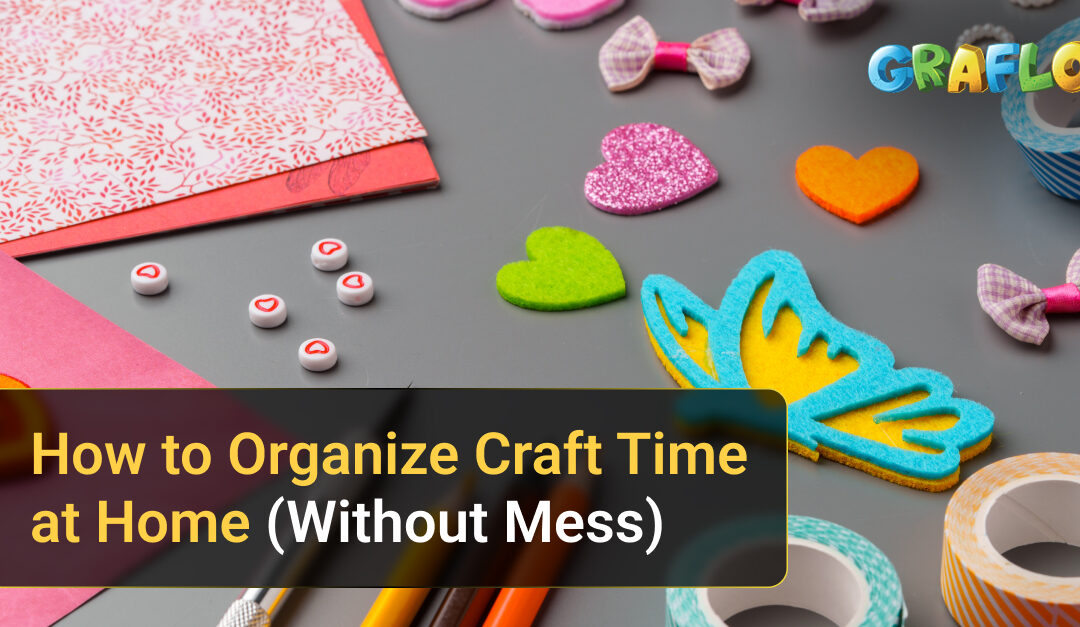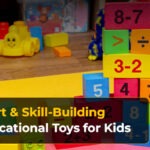Craft time is one of the most joyful and educational parts of a child’s day. It encourages creativity, builds fine motor skills, and gives kids the confidence to express themselves. But for many parents, craft time also brings an unavoidable side effect: the mess. Glitter on the floor, glue on the table, scraps of paper stuck to socks, it can all feel overwhelming.
The good news? With a few smart strategies and with the right kids craft kits, you can make craft time fun, structured, and surprisingly clean. Let’s explore how to organize craft time at home without turning your living room into an art studio gone wild.
1. Create a Dedicated Craft Space
The first step to keeping things organized is designating a craft area. You don’t need a separate room, just a defined corner or table that becomes your child’s creative zone.
Choose a spot that’s easy to clean, such as the kitchen table or a section of the playroom. Use a vinyl or plastic tablecloth to protect surfaces and make cleanup simple. You can even set up foldable tables for easy storage after crafting sessions.
If you want to keep the area inviting, let your child decorate it. Hang their artwork on the wall, use colorful bins, or label drawers with stickers. This not only makes the space feel special but also encourages responsibility for keeping it tidy.
2. Stock Up on Essential Supplies
Before craft time begins, make sure you have all the necessary materials organized and easily accessible. The key here is quality over quantity. Having too many supplies can lead to clutter, confusion, and waste.
Start with the basics:
- Non-toxic paints and brushes
- Washable markers and crayons
- Construction paper
- Glue sticks and child-safe scissors
- Stickers, pom-poms, and googly eyes
If you’re new to crafting, a great way to start is by using kids craft kits. These kits come pre-packed with everything your child needs for specific activities, from art painting to DIY jewelry. They save time, reduce waste, and eliminate the chaos of mismatched supplies.
For example, Graflo’s Art and Crafts Kits offer fun, themed sets that make creative play both structured and mess-free. Each kit includes pre-cut pieces, safe materials, and step-by-step guides, perfect for parents who want simplicity without sacrificing fun.
3. Use Clear Storage Solutions
An organized craft space relies on smart storage. Transparent bins, jars, and drawers make it easy to find what you need while keeping things neat. Group similar items together, paints in one bin, paper in another, and so on.
Label everything clearly. You can print labels or use masking tape and a marker. For younger kids, consider using pictures on the labels (like a glue bottle or crayon image) so they can easily identify where things belong.
Keep small items like buttons, beads, and sequins in clear jars or divided boxes. This not only keeps them organized but also helps children learn sorting and color recognition skills.
4. Set Clear Rules Before You Start
Kids love freedom during craft time, but setting boundaries upfront can save you from a post-craft disaster. Establish a few simple ground rules, such as:
- Craft materials stay on the table.
- Glue and paint need adult supervision.
- Hands must be washed before and after crafting.
- Everyone helps with the cleanup.
Make these rules part of the routine, and over time, your children will follow them naturally. You can even turn cleanup into a fun challenge; set a timer and see who can organize the supplies the fastest!
5. Use Drop Cloths or Craft Mats
No matter how careful your kids are, spills happen. Protect your floors and furniture by using drop cloths, craft mats, or old newspapers. These are inexpensive and easy to replace.
If you want a more durable option, invest in washable craft mats. They’re reusable, eco-friendly, and easy to wipe clean. Keep a few old rags or wet wipes nearby for quick cleanup of glue or paint splashes.
6. Organize by Activity Type
Instead of mixing all your materials, organize supplies by activity. Create separate bins or folders for painting, paper crafts, clay modeling, or seasonal crafts. This way, your child can choose what they want to make without rummaging through everything.
For instance:
- Painting Bin: Brushes, paints, palettes, water cups.
- Paper Crafts Bin: Scissors, glue, paper, stickers.
- Clay Bin: Modeling clay, sculpting tools, and mats.
This system not only keeps things organized but also encourages independent play. Your child learns to pick a bin, complete a project, and clean up one category of materials at a time.
If you’re using kids craft kits, store each kit separately in labeled containers or resealable bags. The Graflo kids craft kits are great examples of how packaging can simplify storage; each set is compact, themed, and easy to stack or store neatly on a shelf.
7. Keep Cleanup Supplies Handy
Having cleanup tools within arm’s reach makes a big difference. Keep a small cleaning basket near your craft area with essentials like:
- Baby wipes or damp cloths
- Small broom and dustpan
- Paper towels
- Trash bag
- Disinfectant spray
Encourage your kids to use these items themselves (with supervision). Teaching children to clean as they go fosters responsibility and helps them appreciate the effort that goes into keeping a shared space tidy.
8. Plan Crafts in Advance
Spontaneous creativity is wonderful, but planning ahead reduces chaos. Choose one or two craft activities per week and prepare the supplies in advance.
You can find plenty of ideas online or simplify your life by subscribing to monthly kids craft kits. These kits often come with new themes and projects each month, saving you the hassle of searching for ideas or materials.
For example, Monthly Craft Subscription Box delivers ready-to-go projects that are age-appropriate and fun. Each month, your child receives everything they need to create something new, whether it’s a paper puppet, 3D model, or painting set. This approach turns crafting into an exciting routine rather than a messy surprise.
9. Encourage “One Project at a Time”
One of the main reasons craft time becomes messy is because kids start multiple projects at once. Stick to the one-project-at-a-time rule. This ensures focus, better results, and easier cleanup.
Once your child finishes a project, display it proudly or store it in a labeled art folder. Celebrate their creativity; hang their crafts on a “gallery wall” or keep them in a scrapbook. Having a system for storing completed crafts motivates children to finish what they start and prevents paper piles from taking over your home.
10. Use Recyclable and Easy-to-Clean Materials
Choosing the right materials can make craft time cleaner and more sustainable. Opt for washable paints, non-toxic glues, and reusable items. Avoid glitter (or use biodegradable glitter alternatives), which is notoriously hard to clean.
Encourage your child to use recycled materials, old magazines, cardboard boxes, or bottle caps for eco-friendly creativity. This not only reduces waste but also teaches valuable lessons about sustainability.
If you prefer a neater alternative, try kids craft kits that already include pre-cut and recyclable materials. Brands like Graflo design kits that minimize mess and maximize creativity; no extra cutting or trimming needed!
11. Set a Cleanup Routine
The golden rule of organized craft time: no project ends without cleanup. Turn cleanup into a habit, not a chore.
Make it part of the crafting session itself; for instance, allocate the last 10 minutes for organizing supplies and wiping down surfaces. Play music during cleanup time to keep the energy positive.
Assign roles: one child collects brushes, another wipes the table, and someone else closes glue bottles. When children see that everyone contributes, they learn teamwork and respect for shared spaces.
12. Keep Craft Time Manageable
Craft time doesn’t have to last for hours to be meaningful. A well-planned 30-minute session can be just as productive (and far less messy) than an unstructured hour.
Limit the number of supplies available at once. For example, instead of opening every paint bottle, give your child two colors to start. This reduces spills and decision fatigue.
By keeping craft sessions short and structured, you’ll find it easier to manage cleanup and maintain enthusiasm over time.
13. Rotate Supplies to Keep Things Fresh
Kids can get bored easily when they see the same materials every week. Try rotating supplies to keep the excitement alive. Store some items away and reintroduce them later.
This approach keeps crafting sessions interesting and prevents unnecessary clutter on the table. You can also introduce new themes: seasonal crafts, nature-inspired art, or learning-based projects like alphabet collages.
Kids craft kits are excellent for this rotation strategy since each kit introduces a unique activity.
14. Lead by Example
Children mirror what they see. If you stay organized and enjoy the creative process, they will too. Sit with your kids during craft time, help them plan their projects, and show them how to clean up after.
When parents participate, kids see crafting not just as playtime but as a shared, meaningful experience. It becomes about connection, creativity, and confidence, not chaos.
15. Enjoy the Process, Not Perfection
Finally, remember that craft time is about joy, not flawless creations. A little mess is part of the magic. The goal isn’t a spotless home but a structured system that makes creativity manageable.
With proper organization, clear routines, and helpful tools like kids craft kits, you can enjoy art time without worrying about the aftermath.
So, grab a few colorful supplies, set up your space, and let imagination run wild: the organized way!
Final Thoughts
Crafting at home doesn’t have to be a battle between creativity and cleanliness. With intentional planning, thoughtful storage, and ready-to-use tools like Graflo’s kids craft kits, you can enjoy the best of both worlds: creative fun for your children and peace of mind for yourself.
After all, the goal is simple: create memories, not mess.






